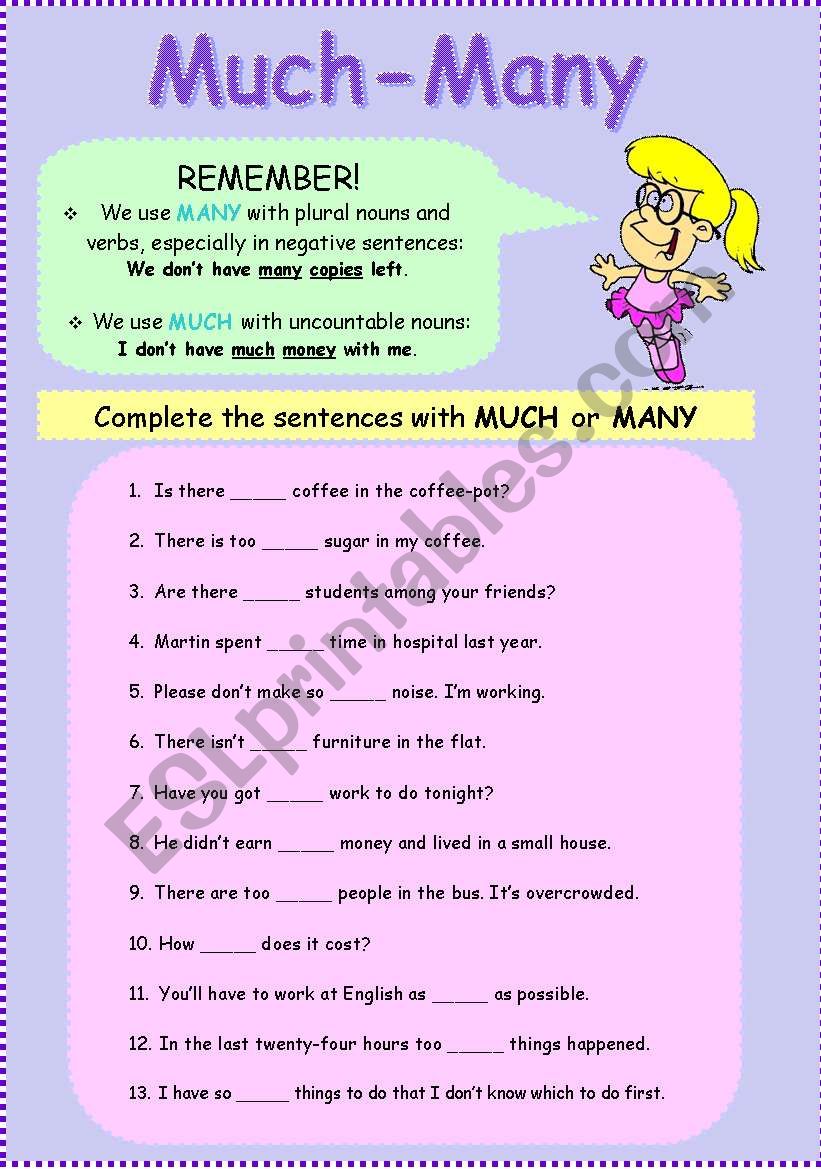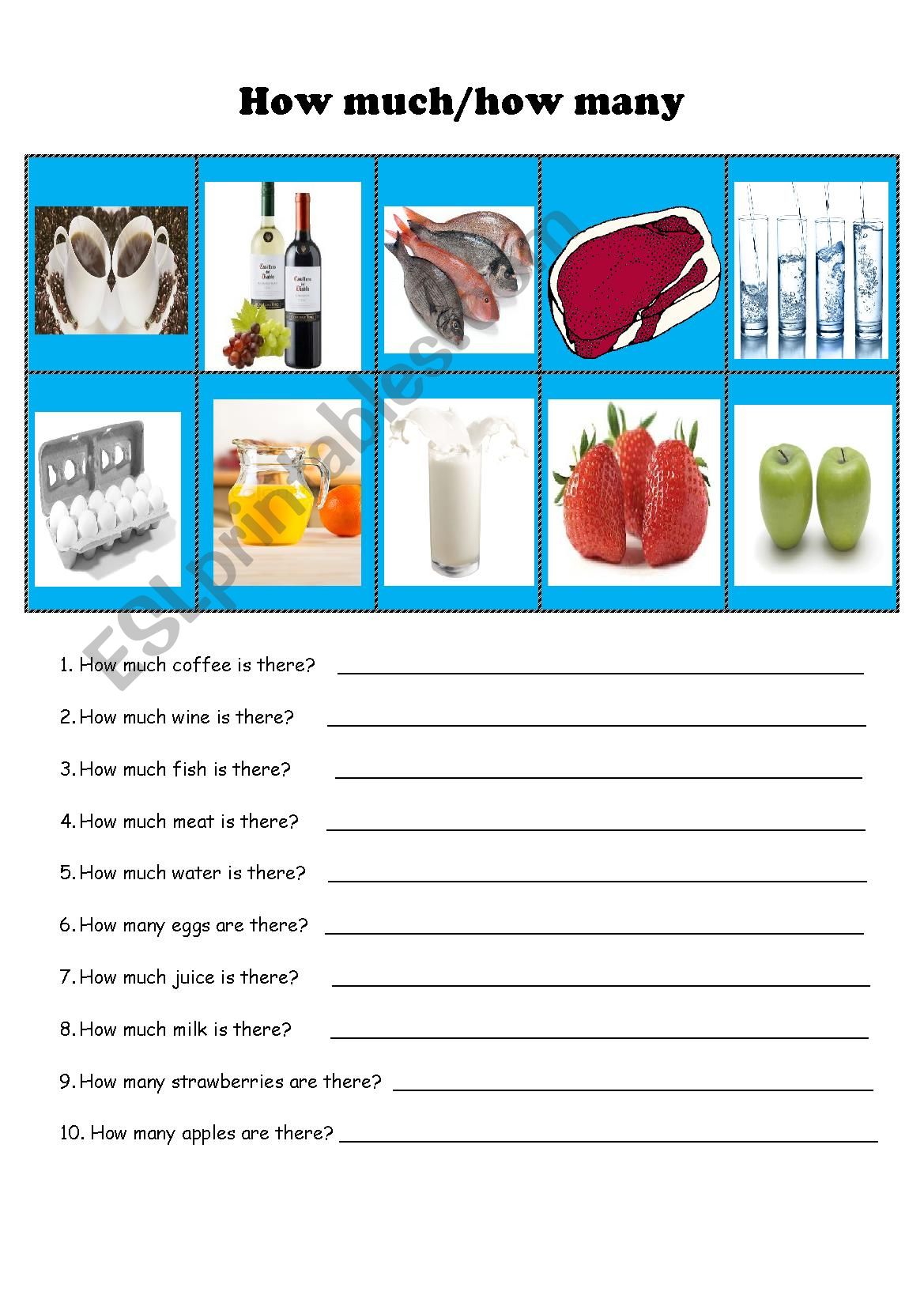
Mastering Quantifiers: The Indispensable Role of Grammar Worksheets: Much/Many
In the intricate tapestry of the English language, precision is paramount. Among the many grammatical nuances that often challenge learners, the correct usage of quantifiers like "much" and "many" stands out as a frequent stumbling block. These seemingly simple words carry significant weight, determining whether we are referring to countable items or uncountable substances, abstract concepts, or quantities. Misusing them can lead to awkward sentences, misunderstandings, and a general lack of fluency. This is precisely where the strategic application of well-designed Grammar Worksheets: Much/Many becomes not just beneficial, but truly indispensable for learners at all levels.
This article delves into the fundamental principles governing "much" and "many," explores the compelling reasons why dedicated worksheets are essential for their mastery, outlines various types of effective exercises, and provides insights into integrating them into a comprehensive language learning strategy.

The Core Concepts: Much vs. Many

Before diving into the role of worksheets, it’s crucial to firmly grasp the distinction between "much" and "many."

-

Much: This quantifier is used with uncountable nouns. Uncountable nouns refer to things that cannot be counted individually, often existing as a mass or a concept. They do not typically have a plural form.
- Examples: water, information, money, time, advice, happiness, knowledge, traffic, air, sugar, rice, furniture.
- Usage: "How much water do you need?" "I don’t have much time." "There isn’t much information available."

-

Many: This quantifier is used with countable nouns. Countable nouns refer to individual items that can be counted and have both singular and plural forms.
- Examples: books, students, ideas, cars, chairs, problems, apples, countries, reasons.
- Usage: "How many books did you read?" "There are many students in the class." "Do you have many ideas?"



It’s also important to note that while "much" and "many" are commonly used in questions and negative sentences, "a lot of" or "lots of" are often preferred in affirmative sentences, especially in informal contexts, as they can be used with both countable and uncountable nouns, thus offering a convenient alternative. For instance, instead of "I have much money" (which sounds less natural), "I have a lot of money" is more common. However, understanding "much" and "many" is still vital for constructing questions, negatives, and for more formal writing.
Why Worksheets are Essential for "Much/Many" Mastery
The journey from understanding a grammatical rule to confidently applying it in real-time communication is often a long one. This gap is precisely what effective practice tools, particularly worksheets, aim to bridge. For "much" and "many," Grammar Worksheets: Much/Many offer several distinct advantages:
- Repetitive Practice: Grammar, like any skill, requires repetition. Worksheets provide a structured environment for learners to encounter and apply the rules multiple times, reinforcing the correct usage until it becomes intuitive.
- Targeted Focus: Unlike general conversation or reading, worksheets isolate the specific grammar point. This focused attention allows learners to concentrate solely on distinguishing between countable and uncountable nouns and applying the appropriate quantifier without distraction.
- Immediate Reinforcement/Feedback: Many worksheets come with answer keys, allowing learners to check their work immediately. This instant feedback loop is crucial for self-correction and solidifying understanding. In a classroom setting, teachers can quickly identify common errors and address them.
- Variety of Contexts: Effective worksheets present "much" and "many" in diverse sentence structures and scenarios, helping learners understand how these quantifiers function in different linguistic contexts. This moves beyond rote memorization to genuine comprehension.
- Building Confidence: Successfully completing exercises builds confidence. As learners correctly apply "much" and "many" repeatedly, they feel more secure in their grammatical abilities, reducing hesitation in speaking and writing.
- Identifying Gaps: For both learners and educators, worksheets serve as diagnostic tools. Persistent errors on specific types of questions reveal areas where further instruction or practice is needed.
Types of Effective Grammar Worksheets: Much/Many Exercises
To ensure comprehensive learning, Grammar Worksheets: Much/Many should incorporate a variety of exercise formats. A diverse approach keeps learners engaged and tests their understanding from multiple angles:
-
Fill-in-the-Blanks: The most common type, where learners choose between "much" or "many" to complete sentences.
- Example: "There isn’t ____ milk left." (much)
- Example: "How ____ friends do you have?" (many)
-
Choose the Correct Option: Similar to fill-in-the-blanks, but provides a choice from a set of options (e.g., "much / many / a lot of").
-
Sentence Completion/Creation: Learners are given a noun (countable or uncountable) and must construct a grammatically correct sentence using "much" or "many" with it.
- Example: "Write a sentence using ‘information’ and ‘much’."
-
Error Correction: Sentences are provided with incorrect usage of "much" or "many," and learners must identify and correct the error. This requires a deeper understanding of the rules.
- Example: "I don’t have many money." (Correction: "I don’t have much money.")
-
Question Formation: Learners are given an answer and must formulate a question using "how much" or "how many."
- Example: "Answer: I need two hours to finish. Question: How many hours do you need?"
-
Dialogue Completion: A conversation is presented with gaps where "much" or "many" (or "how much/many") must be inserted, providing contextual practice.
-
Categorization: Learners are given a list of nouns and must categorize them as "countable" or "uncountable," a foundational skill for using "much" and "many."
-
Picture-Based Activities: Visual prompts can make learning more engaging. Learners describe pictures using "much" or "many" (e.g., "There isn’t much grass," "There are many trees").
-
Real-World Scenarios: Presenting scenarios like grocery shopping lists, party planning, or travel preparations, where learners naturally need to quantify items, adds practical relevance.
Designing and Implementing Effective Worksheets
For educators and self-learners creating their own materials, a few principles can enhance the effectiveness of Grammar Worksheets: Much/Many:
- Clear Instructions: Ensure learners understand exactly what they need to do for each exercise.
- Gradual Difficulty (Scaffolding): Start with simpler exercises (e.g., direct fill-in-the-blanks) and progress to more complex ones (e.g., error correction, sentence creation).
- Contextualization: Sentences should be meaningful and relatable, not just isolated grammatical structures.
- Inclusion of Tricky Cases: Address nouns that are commonly mistaken (e.g., "furniture," "advice," "news" are uncountable; "people," "sheep," "fish" can be tricky countables/plurals).
- Answer Keys: Crucial for self-study and quick checking in a classroom setting.
- Visual Appeal: Well-organized, clean layouts with appropriate spacing and sometimes simple graphics can improve engagement.
- Variety Within a Worksheet: Mix different exercise types within a single worksheet to keep it dynamic.
When integrating these worksheets into a learning routine, consider them for:
- Pre-lesson Assessment: To gauge existing knowledge.
- During-lesson Practice: To immediately apply newly learned rules.
- Homework Assignments: For independent reinforcement.
- Review Sessions: To consolidate learning before tests.
- Collaborative Activities: Learners can work in pairs or small groups to complete and check worksheets, fostering peer learning.
Overcoming Common Pitfalls with Worksheets
Learners often struggle with "much" and "many" due to several common pitfalls, which well-designed worksheets can help address:
- Native Language Interference: Many languages do not have a direct equivalent distinction between countable and uncountable nouns in the same way English does, leading to direct translation errors. Worksheets provide the specific English patterns.
- Misidentifying Noun Types: Learners might incorrectly categorize a noun as countable when it’s uncountable (e.g., "informations" instead of "information"). Categorization exercises and repeated exposure in worksheets help solidify this distinction.
- Over-Generalization of "A Lot Of": While "a lot of" is versatile, over-reliance on it prevents learners from mastering "much" and "many" for situations where they are more appropriate or required (e.g., formal writing, specific question structures). Worksheets specifically target the "much/many" forms.
- Lack of Sufficient Practice: Without dedicated practice, the rules remain theoretical. Worksheets offer the necessary repetition for automaticity.
By systematically working through diverse Grammar Worksheets: Much/Many, learners can confront these challenges head-on, receive targeted practice, and internalize the correct usage, moving beyond simple memorization to genuine understanding and application.
Beyond the Worksheet: Extending Learning
While worksheets are powerful tools, they are part of a larger learning ecosystem. To truly master "much" and "many," learners should also:
- Engage in Oral Practice: Use flashcards with nouns and ask "How much/many…?" questions aloud. Participate in role-plays that require quantification.
- Listen Actively: Pay attention to how native speakers use "much" and "many" in conversations, podcasts, and media.
- Read Authentically: Notice the usage of these quantifiers in books, articles, and online content.
- Write Regularly: Incorporate "much" and "many" into essays, emails, journal entries, and reports.
- Utilize Online Resources: Many interactive websites and apps offer gamified exercises that complement traditional worksheets.
Conclusion
The correct application of "much" and "many" is a hallmark of clear and accurate English communication. While the concepts are straightforward, their consistent and confident usage requires deliberate practice. Grammar Worksheets: Much/Many serve as an invaluable cornerstone in this learning process, providing the structured, repetitive, and targeted practice necessary to transform theoretical knowledge into practical proficiency. From reinforcing the fundamental distinction between countable and uncountable nouns to addressing common errors and building learner confidence, these worksheets are indispensable tools for anyone striving to master these essential quantifiers. By integrating them thoughtfully into a comprehensive language learning strategy, learners can bridge the gap from confusion to clarity, paving the way for more fluent, precise, and effective English communication.
